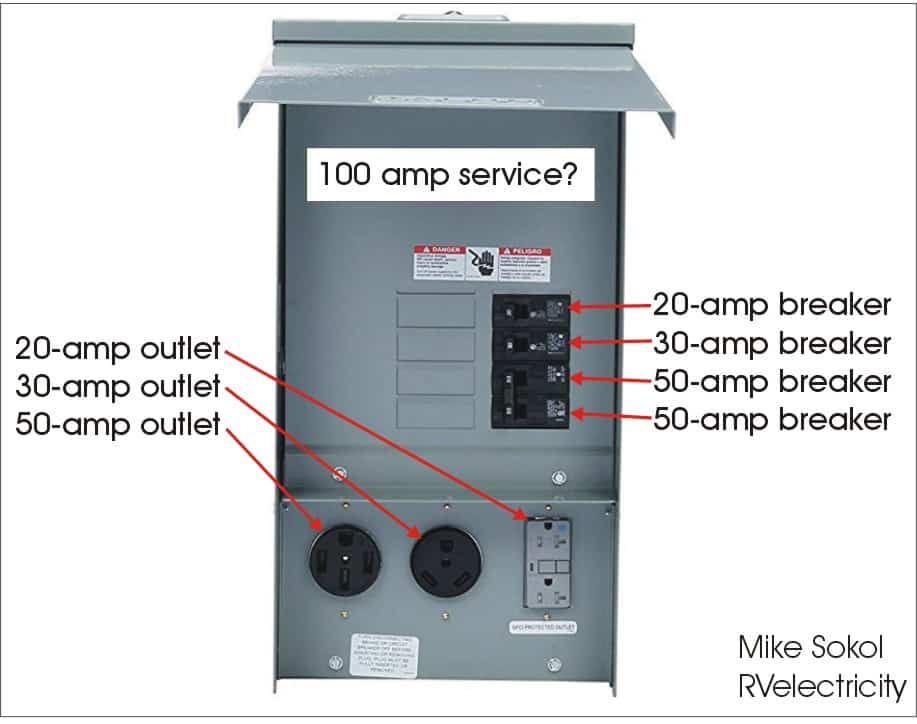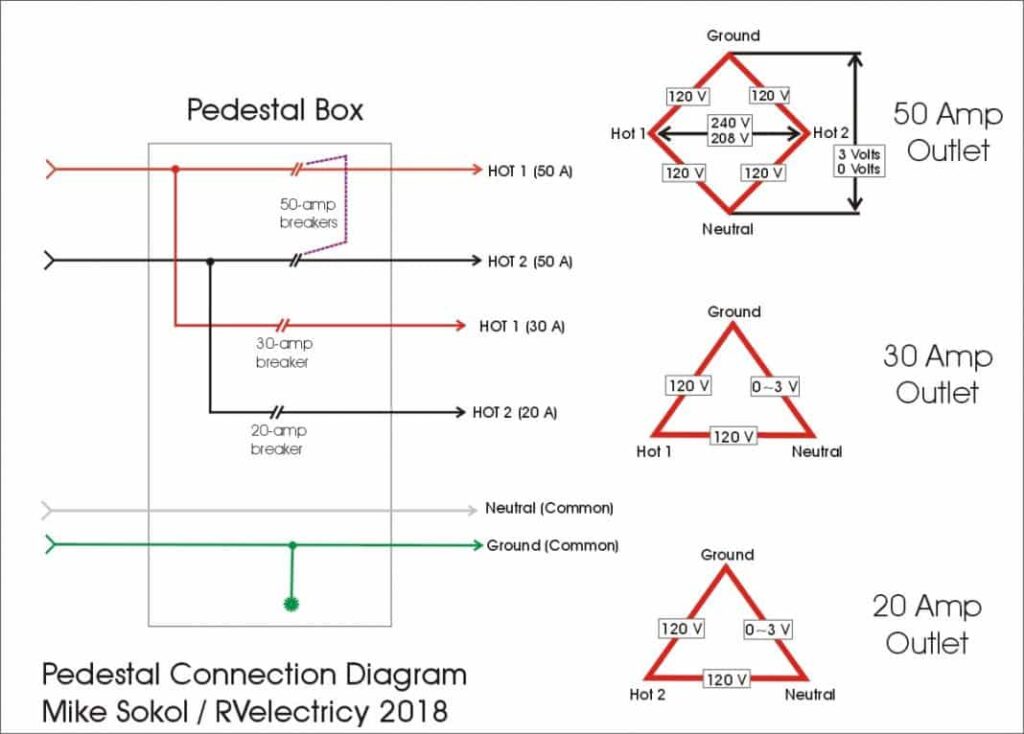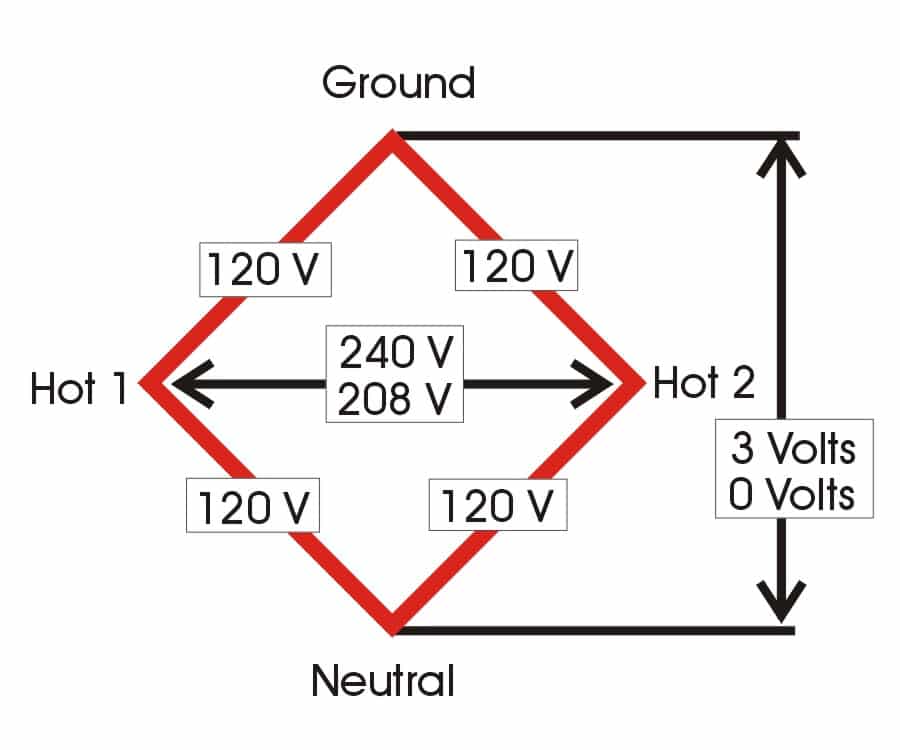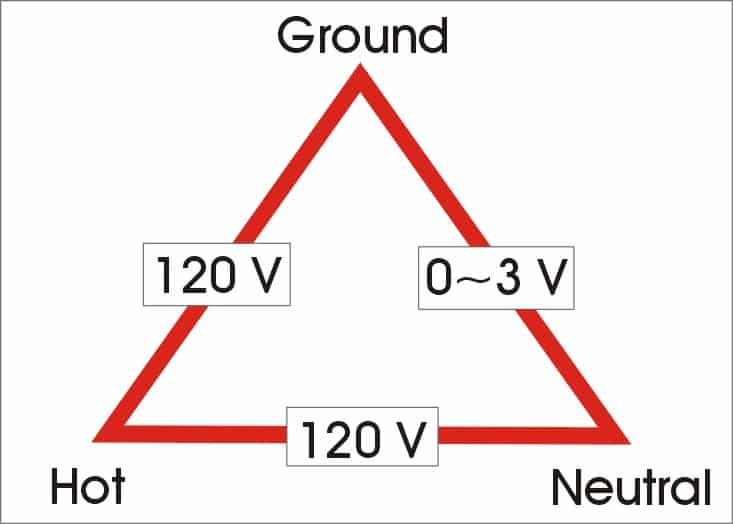RV Power Pedestals – RV Outlet Basics
Because there’s been so much debate about 120/240-volt power on sites that cover RV electricity, this is an excellent time to explain how 20-, 30- and 50-amp pedestal hookups function and how they should be measured.

Let’s start with pedestal voltages. In a typical campground pedestal, 20-, 30- and 50-amp circuit breakers supply 20-, 30- and 50-amp outlets. Note that while the 20- and 30-amp outlets are fed by single circuit breakers with a single handle, the 50-amp outlet is fed by a double (2-pole) circuit breaker.

This is a diagram of what’s connected inside the pedestal. You’ll notice that there should be a 120/240-volt, 2-pole service going into the pedestal, which will be properly current limited by suitable circuit breakers. There’s a 50-amp/120/240-volt/2-pole circuit, a 30-amp/120-volt/single-pole circuit, and a 20-amp/120 volt single pole circuit from top to bottom.
The other thing to consider is that the 50-amp circuit has two 50 amp limbs (legs), for a total of 100 amps in the circuit. As long as you don’t exceed 50 amps on either limb, it can provide a total of 100 amps at 120 volts (50 + 50 = 100).
The RV outlet for each of these circuits is specified by NEMA and the NEC, with the 50-amp outlet using the same 50-amp/240-volt NEMA 14-50 receptacle that may be found in houses to power a cooktop and range top.
The 30-amp circuit is distinct to the RV industry, using a NEMA TT-30 connector (TT as in travel trailer), and it’s only rated for 120 volts, not 240 volts like its home dryer outlet counterpart, which is properly wired with 2 poles.As many as a few hundred emails arrive every day regarding this, implying that someone is miswiring a 30-amp TT-30 outlet with 240 volts and causing an RV electrical system to fail.
The final, albeit little, thing to remember is that the modest Edison outlet, which comes in both 15- and 20-amp versions. Even a 15-amp version will pass a complete 20 amps of current if it’s connected to a 20-amp circuit breaker and 12 gauge wiring.Note that it’s the only outlet on a pedestal that needs GFCI protection, which is why you’ll see a TEST and RESET button.

The goal is to establish a subtractive neutral condition by using the Hot-1 and Hot-2 connections. The neutral wire and contacts won’t be able to carry more than 50 amps of current because of this -208 or -240 volt potential between the Hot-1 and Hot-2 contacts. If the campground only has one leg going to both shore power terminals, the neutral wiring and circuit breakers could be forced to carry up to 100 amps of current without tripping, which isn’t ideal at all. That’s because the RV plug, surge protector, and shore power cable might all be fried by over-current and/or catch fire.
As previously stated, the Hot-1 and Hot-2 poles on a 50-amp outlet should both have a voltage of roughly 120 volts between them. There may be anywhere from 1 to 3 volts measured between the neutral and ground contacts, which is quite normal and acceptable given typical voltage drops in the neutral wire feeding your pedestal.

The 20- and 30-amp outlets should have the same size, voltage, and amperage, with 120 volts available through the circuit breakers. It’s typical to detect perhaps 2 or 3 volts between the neutral and ground on a loaded circuit; this is completely safe and to be anticipated.
However, be particularly careful when connecting to any NEW 30-amp outlets. Some home electricians may mistake them for 1970s dryer outlets, which were (and still are) wired with two poles of power and produced 240 volts. If you connect your 30-amp shore power cable into one of these, all of your RV’s electrical systems and appliances will suffer a catastrophic meltdown.
\









Leave a Reply
You must be logged in to post a comment.